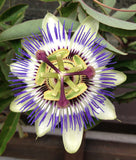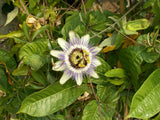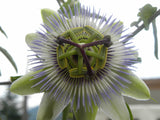Passiflora caerulea, commonly called blue passionflower, blue crown passionflower, and common passionflower, is a woody, perennial, deciduous, tendril-forming vine in the passionflower family of Passifloraceae. This woody vine is native to South America and reaches 20-30ft in height at maturity. The leaves grow up to 4 inches in length in an alternating pattern and palmately shaped with 5, 7, or 9 lobes connecting at the center. Tendrils protrude from the base of leaves in search of support for the vine and are around 2 to 4 inches in length. Passiflora caerulea has complete flowers that are 4 inches in diameter. The flowers have 5 white petals, and 5 sepels that resemble petals. Blue to violet corona filaments form a ring above the petals. The flower also has 5 yellowish green stamens and 3 purple stigmas. Passiflora caerulea fruits are oval shaped and egg sized. The fruits have orange skin and juicy red flesh covering the seeds inside. Passiflora Caerulea is a climbing plant that relies on other plants or structures for support. Without something to climb, it will sprawl along the ground and may turn into a ground cover. Passiflora caerulea has multiple uses as medicine and as a food crop. The leaves, flowers, and fruit are edible. Juices can be made from the fruit. (Caution: consuming high amounts of raw leaves may expose the body to small amounts of cyanide). Other passion fruit species have more highly sought after fruit, however the flowers contain higher amounts of the MAO-inhibitor, harmine, in this species compared to others such as Passiflora incarnata. Medicinal teas are made out of the flower to battle anxiety and insomnia. P. caerulea enjoy frequent fertilizations, good support to climb on, and pruning during late winter/early spring before growth begins. Well-drained soil with high organic matter is an ideal medium to grow in. Soil should be kept moist but can occasionally become dry. The plant enjoys full sun to partial shade. Passiflora caerulea thrives in subtropical, tropical, mediterranean, and temperate climates with a USDA plant hardiness zone of 6a-10b.
Passiflora caerulea seeds should be pretreated with a light scarification from sandpaper or file which significantly reduces germination time as the seed coat is hard. After scarification, soak the seeds in warm water for 24 hours prior to planting. Plant the seeds ½ to 1 inch deep in a well draining potting mix. Plant the seeds at least ½ inch apart from each other to prevent overcrowding. Keep in high moisture and humidity but make sure the soil does not stay soaking wet. Ideal germination temperature is between 60°F to 85°F. Germination typically takes 10-21 days with pretreated seeds. Seeds without pretreatment may take months to germinate. Even with optimal conditions, germination may be slow and sporadic.
INTERNATIONAL SHIPPING DISCLAIMER:
All packages will be shipped with basic customs information such as; HS codes, VAT numbers, and properly labeled contents. Unfortunately, The Garden of Set is unable to provide phytosanitary certificates for orders at this time. It is the buyer’s responsibility to know local laws regarding the import of plants, seeds, and plant products into their country. It is also up to the buyer to provide any other customs forms or information required to import plants into their country. If packages get stopped by customs, The Garden of Set will not be able to provide a refund for the purchase. Most of the time packages make it to their destinations just fine, this is for the small minority of packages that get stopped without having all the proper customs information required by the country of import. Purchase at your own discretion.








